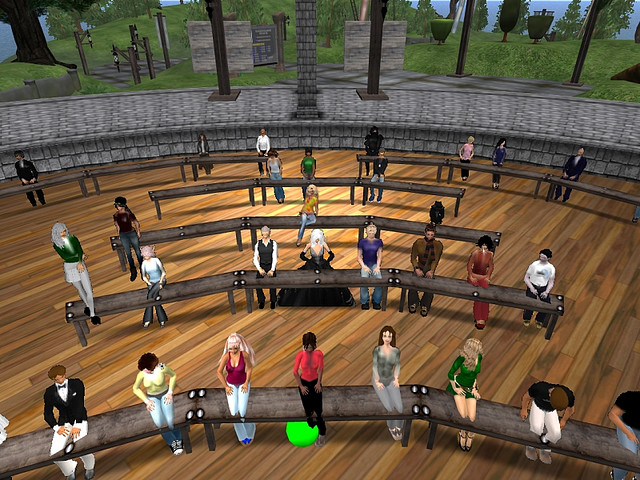Best Practices in Virtual Education

Participants listen to anthropologist Tom Boellerstorm speak at the Virtual Worlds--Best Practices in Education conference in Second Life in 2009
Many groups exist in Second Life for the invention, promotion, and maintenance of educational activities, and some of these groups are among the most active in the virtual community. One of the most influential of these groups is Virtual Best Practices in Education. A conference, the Virtual Worlds – Best Practices in Education, is held annually in-world and includes invited presentations on “teaching/learning, scholarly work, projects, events, activities and new and innovative tools for virtual education” in multiple formats including “lectures, workshops, tutorials, on-site and off-site tours, roundtables, discussion panels, and multi-media” (http://www.vwbpe.org/). Registration is free for the three-day conference. In 2011, two competitions were sponsored to promote the event, including a poster competition and a machinima competition. Links to the winners, as well as comprehensive information about the conference, are available on the website. Residents can involve themselves in the year-long conference planning process. VWBPE is sponsored (held in-trust) by Rockcliffe University Consortium, which manages and maintains open-source archival access of all the materials presented at the conference. They do not charge for this service and access is free to all (“About”).
VWBPE’s call for papers is also featured on their website, and shows an awareness of the need for development of activities that provide structure to engage students in Second Life. For example, the “Games and Simulations FEST CFP” solicits submissions of mini-games, games within games, role-play, simulations, guild structure/badges/pointification, and a miscellaneous category. The participants are given a virtual space to exhibit their game that informs visitors by a variety of methods: notecard (which explains the game’s purpose in text), machinima, video or pictures of the game, or instructions to visitors on how to actually play the game. This encouragement for demonstration across multiple contexts can certainly be more interesting to visitors than the delivery of a paper or a slide show (although the conference also makes allowances for those methods of delivery).
Interestingly enough, the VWBPE group’s management of the conference through the website and the virtual community event follows the formula that I later present as the vPortfolio. The website serves as a hub for the events that take place and the artifacts that are produced both in and out of the virtual world. In addition to the main web interface, committee members and participants present and discuss agendas and items of interest via wikis, blogs, and other web-based tools as well as through groups created in Second Life; these groups also may have meetings in Second Life. It is this cycle of presentation, interaction, feedback, and reflection that is essential to the ePortfolio learning cycle and a key feature of the proposed vPortfolio. The vPortfolio is, simply, an interface designed and maintained by its author (which may be a group as well as an individual) that integrates virtual world contexts in this cycle of presentation, reflection, connection, and feedback.
The virtual campus, then, may or may not serve as a tool for effective learning in the virtual world. It depends on what is done with it; in itself, it is likely to garner admiration and pique initial curiosity, but not sustained engagement. People are what drive learning in Second Life, but they need a system by which to build the networks and connections that provide a road for that drive.
